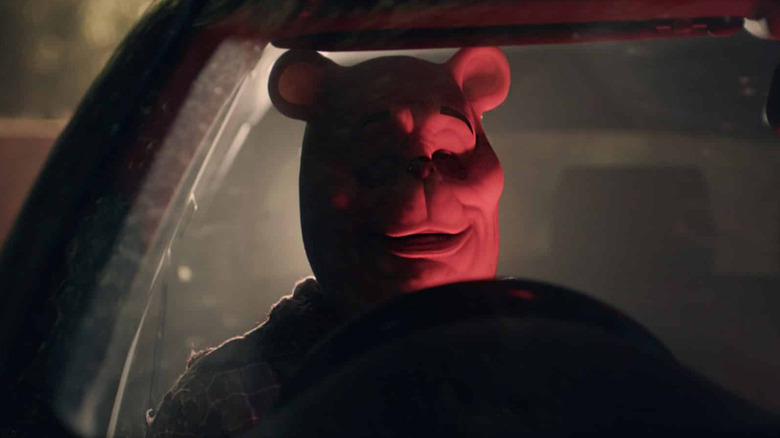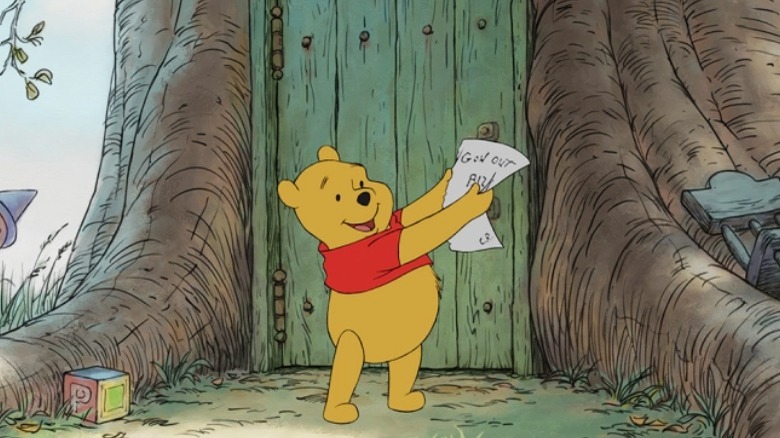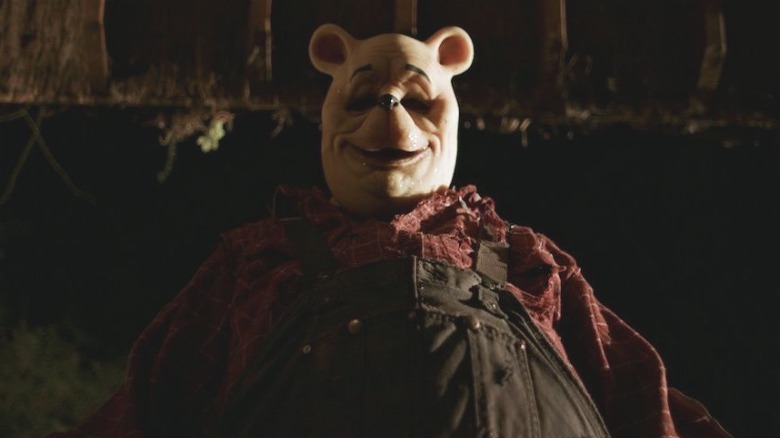Why The First Draft Of Winnie-The-Pooh: Blood And Honey Was 'Unfilmable'
A.A. Milne and E.H. Shepard's beloved "Winnie-the-Pooh" universe entered the public domain in 2022, making its characters (with the exception of Tigger) instantly usable for adjacent creative projects. Although Pooh and his pals in Hundred Acre Wood are traditionally kindhearted and guileless, director Rhys Frake-Waterfield decided to make a hard pivot and reimagine these creatures as bloodthirsty murderers in "Winnie-the-Pooh: Blood and Honey." This complete and shocking re-contextualization allows the film to function as a violent slasher, where the otherwise "hunny"-loving anthropomorphic bear goes on a blood-soaked rampage alongside his feral friend, Piglet. Gone is the nostalgic charm of Hundred Acre Wood, as the space has now been transformed into a hunting ground rigged with dangerous death traps.
Frake-Waterfield's initial efforts to approach Milne and Shepard's heartwarming source material were mired in complications, as the problems that plagued the writer-director were multifold. Firstly, his approach to these characters had to be wholly original, as Pooh and his friends are characters associated with innocence and warmth, and meant to offer solace. Moreover, repainting Pooh and Piglet as blood-thirsty killers who feel the need to enact revenge on Christopher Robin ran the risk of being tonally one-note or unfounded even within the context of a slasher, and Frake-Waterfield had to tread carefully when it came to convincingly structuring his overarching story.
Clearly, "Winnie-the-Pooh: Blood and Honey" is not for those who wish to cling on to the innocence of their comfort woodland creatures, as the film dives headfirst into territories that are rather twisted and discomfiting. Interestingly, however, the original script draft for the film was deemed "unfilmable" not because of its content, but due to reasons related to copyright laws.
Copyright, the true source of terror
Rhys Frake-Waterfield is uncompromising in his vision for a murderous Pooh and Piglet in his slasher, as he has not shied away from having them brutally murder and cannibalize their beloved friend, Eeyore. In "Blood and Honey," these creatures are driven by a rabid sense of retribution, which has led them to hunt down and devour anyone who crosses their path. The problem with Frake-Waterfield's first draft was not that it was too gory, as the writer-director gladly wishes to push the envelope when it comes to creating a grisly, ruthless world for his film.
Instead, the issue was that he had to be extremely careful about the iterations of the characters he could draw inspiration from, as the ones under the Walt Disney trademark would have immediately led to copyright infringement. In an interview with Yahoo Entertainment, Frake-Waterfield explained this issue in greater detail:
"It was unfilmable. [...] I had to literally trash that script and start anew. [...] I had to be really careful about what I was drawing inspiration from. Only the 1926 version is in the public domain, so those were the only elements I could incorporate. Other parts like Poohsticks, and Tigger, and Pooh's red shirt — those aren't elements I can use at the moment because they're the copyright of Disney and that would get me in a lot of trouble. The first script had a lot of those elements in it, and those elements would have really encroached onto Disney branding and IP."
Frake-Waterfield is referring to Milne's 1926 "Winnie-the-Pooh" novel, which was the only source he could incorporate elements from. Everything else, especially material from Disney-made animated films and television shows, was strictly off-limits, including the popularized images of Pooh wearing a red T-shirt or Piglet's cutesy all-pink attire.
Conscious distancing from the Disney IP
Taking advantage of the material made available in the public domain, Rhys Frake-Waterfield situates the narrative of "Blood and Honey" years after Christopher Robin's visits to the Hundred Acre Wood as a child. This allows him to twist a familiar premise into something altogether frightening, and drastically alter Pooh and Piglet's personalities in the wake of their abandonment-fueled trauma. Even the decision to allot a slasher-esque tint to the events was motivated by the need to evade Disney lawyers, as Frake-Waterfield wanted to distance his rendition of the Pooh-verse as much as possible from the corporation's traditional iterations. The writer-director explained:
"I took him [Pooh] down the Michael Myers slasher route rather than making him a bit like Chucky, which might be a bit closer to Disney. I wanted to embrace the horror of it, and try to make something quite scary and menacing. That led me towards a completely opposite end from the Disney version, which is obviously designed to be friendly and cuddly."
A combination of these factors gave birth to a script that features R-rated violence, which is miles away from the pleasant, child-friendly Disney-backed projects. Frake-Waterfield also insists on lingering on the motivations of the villain in a horror film, which led him to position Pooh front and center, especially during the gruesome chase and kills.
Although follow up projects to "Blood and Honey" purely depend on audience interest and demand, Frake-Waterfield wishes to introduce more familiar characters in a potential sequel. Brandishing his commitment to ruin everyone's childhood, Frake-Waterfield has also expressed his interest in creating a cinematic universe filled with "twisted" versions of beloved characters, including Bambi and Peter Pan. In Frake-Waterfield's blood-tainted cinematic world, innocence is but a fleeting dream where no legacy comfort characters are safe.


